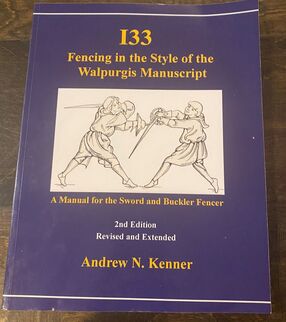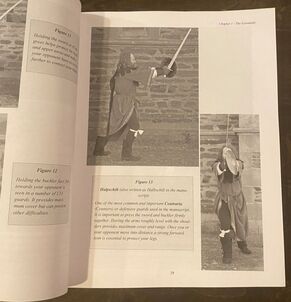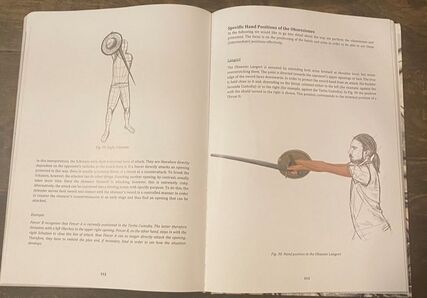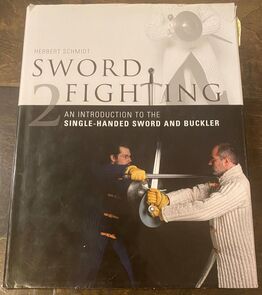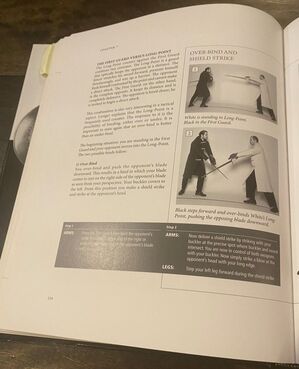Book Review: I33 Fencing in the Style of the Walpurgis Manuscript 2nd edition By Andrew N. Kenner3/10/2024 Today, we will be reviewing Andrew N. Kenner’s book titled I33 Fencing in the Style of the Walpurgis Manuscript 2nd edition. This book covers their interpretation of the I.33 techniques and with the second edition being published in 2016 . I will primarily focus on the book’s value as an interpretation source for new fencers getting started with I.33. I will focus on three major areas: structure, presentation of techniques, and value. I will not comment on the interpretation itself. The validity of the interpretation is up to the reader to decide as they journey down their own research on I.33. StructureKenner begins his book with a forward on the history of the manuscript and its system. He then goes on to discuss equipment for the system as well as foundational swordsmanship concepts like distance management. The I.33 technique starts by introducing the stance in I.33 and highlighting keeping the sword and buckler hands close while performing the binds in the system. The second chapter introduces the attacks and defenses of I.33 which captures the overall strategy of the manuscript. Next, the manuscript covers movement in the system followed by binding and some additional techniques. The later chapters of the book group the wrestling, grappling, and special techniques of I.33 into a single chapter. The book also includes a handful of exercises throughout to help the reader practice the techniques discussed in the section where the exercises are. The structure of the book does an excellent job slowly building up the techniques and organizing the techniques of I.33. The techniques are grouped logically to introduce a ward, then introduce the counters to it. The wards are also further decomposed into high wards and low wards which helps the reader build towards getting a complete picture of the techniques. Presentation of TechniquesOne of the best aspects of Kenner’s book is the bolding of key phrases such as “Vidilpoge” when they are discussed. This allows for techniques to quickly stand out while the reader flips through the pages and enables them to focus on the techniques from the source. The book also features a number of pictures to help the reader visualize what is being discussed. Furthermore, while the fencers in the pictures are wearing period clothing of I.33, they tuck their tunics similarly to what is shown in I.33. This allows the readers to get a better idea of what the fencer’s feet and leg posture are, which further enhances the ability for the reader to learn from the book. ValueAs of writing this blog, Kenner’s book is available for around $22. It is soft-covered and has durable pages that help when reading and practicing at the same time. This makes it one of the most affordable interpretation books available on I.33. Who I Recommend it toThis is an excellent book to start off with. I.33. The techniques discussed are straightforward, and the visuals provide further clarification to the reader. While the techniques are not in the order they are presented in I.33, the bolding of terminology and the images do a decent job of associating Kenner’s interpretation to the manuscript. When paired with a translation of I.33, this book can serve as an excellent guide when someone begins their journey into I.33.
0 Comments
Today, we will be reviewing Bettina Miriam Sehner and Michael Lammer’s book Ultima Custodia, which was published in 2023. This book covers their translation and interpretation of the I.33 techniques and features custom art by Bettina Sehner throughout. I will primarily focus on the book’s value as an interpretation source for new fencers getting started with I.33. I will focus on three major areas: structure, presentation of techniques, and value. I will not comment on the interpretation itself. The validity of the interpretation is up to the reader to decide as they journey down their own research on I.33. Please note, I interviewed Sehner late in 2023 to help promote her book. While I purchased the book myself, I am certainly grateful to Sehner for taking the time to interview me. While I believe my review is objective, it is worth pointing out any bias I may have regarding this book. StructureThe book is broken up into two major focuses. The first is the history of the manuscript and their translation. The second part is their interpretation of the techniques. For the interpretation section, the authors introduce the equipment for learning I.33 and the geometric basics of sword fighting, such as the center line and angles of attack. Next, the wards are introduced, including footwork and other fundamentals of swordsmanship. The interpretation section then covers the counters to the wards and specific attacks in the manuscript. Presentation of TechniquesThe translation section of I.33 includes the images of the manuscript itself which is an incredible inclusion in this book. While this does mean that there is a fair amount of white space in the book, the translations are shown with the page they are from which makes it easy to follow for a reader unfamiliar with I.33. The interpretation section includes descriptive text as well as images to support their descriptions. It also includes three-dimensional renderings of the I.33 technique to add depth to the otherwise two-dimensional art of I.33. ValueAt the time of writing this blog, the book can be purchased at bladenswords.com for about $60. Because this book is a custom project of the site, you must submit a form to order it. While pricier than other interpretations on the market, the book is also hardcover and in color. This color is critical because the book also includes artwork from Sehner which makes the book also an art book, not just a translation and interpretation book. One negative I do have with the book is the purchasing process. Many potential readers may be hesitant to purchase from their site, especially given the cost of the book. However, I purchased my copy of the book this way and had it damaged and lost during shipping. Blade and Swords promptly responded to the issue and re-shipped me a new copy without additional charges. I believe they have also improved their packaging process since then to reduce the chance of that occurring again. Many others have received their copies of the book as well which speaks to the safety of the purchasing process. Who I Recommend It ToThis book is a great I.33 primer book for anyone looking to start their journey into I.33. While on the more expensive side for interpretations, it also doubles as a work of art that can be displayed on coffee tables and around the house. Furthermore, one of the things that forces the book to be more expensive is their inclusion of the pages of I.33, which requires royalty fees to be paid to Royal Armouries. Very few interpretation books doubles as a translation book. If you include the cost of a translation book of I.33 and the cost of a soft-covered interpretation book, you will pay around $60, which helps put into perspective the value of this book.
Today we will be reviewing book titled Sword Fighting 2: An Introduction to the Single-Handed Sword and Buckler by Herbert Schmidt. This book covers Schmidt’s interpretation of a number of sword and buckler systems including I.33. The book was originally published in 2015. I will primarily focus on the book’s value as an interpretation source for new fencers getting started with I.33. I will focus on three major areas: structure, presentation of techniques, and value. I will not comment on the interpretation itself. The validity of the interpretation is up to the reader to decide as they journey down their own research on I.33. StructureSchmidt begins his book with an introduction to the history of sword and buckler and general characteristics of the weapons. He also takes this time to introduce the main sword and buckler sources he will focus on, namely Andre Lignitzer, I.33, Talhoffer, and Paulus Kal. Next, the book covers general principles such as how to hold the sword and the bucker, the poster the fencer should use, binding actions, distance management, and footwork. The fifth chapter of the book includes the terminology and definitions for actions included in I.33. The following chapter includes the attacks and binding actions I.33 uses to strike the opponent safely. Next, each play in I.33 is shown and grouped by the ward they utilize. The later chapters of the book use a similar structure for teaching Talhoffer, Paulus Kal, and Lignitzer. The chapters start with terminology then expand into the plays for those systems. Presentation of TechniquesThe book includes images, text, and blocks of notes to add emphasis for specific details to the reader. The pictures are in black and white (which is common for interpretation books), and the fencers are wearing gambesons that do not mask the body mechanics they are using. The pictures were also clearly taken in a photo room, allowing all of the image detail to be on the fencers without a distracting background. The book's layout is excellent for introducing the techniques and sources Schmidt is interpreting. At all times, it is clear to the reader what source they are learning about and how it relates to the original sources. As a bonus, Schmidt includes an appendix that summarizes the wards and what they are countered by to help the reader quickly remember specific techniques. ValueAt the time of writing this blog, Sword Fighting 2: An Introduction to the Single-Handed Sword and Buckler can be purchased for around $40. While pricier than other interpretation books currently on the market, Schmidt’s book is also hardcover with durable pages which makes the book itself also aesthetically pleasing. Who I Recommend It ToThis is one of the most helpful books I have found on sword and buckler combat and it was foundational to me starting my journey into I.33. While the book is not explicitly a I.33 interpretation book, the book does an excellent job clearly explaining techniques. This is an easy book to recommend, not just to I.33 fencers, but to fencers interested in learning about the wider world of medieval sword and buckler systems
|
Proudly powered by Weebly
